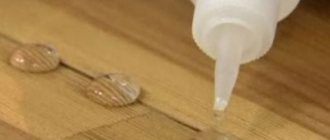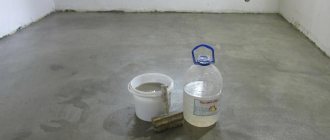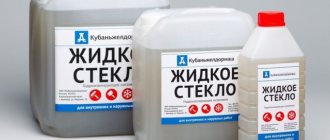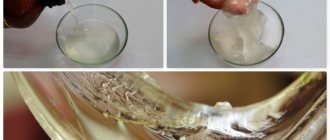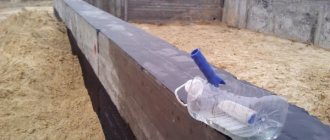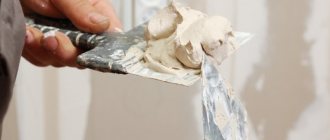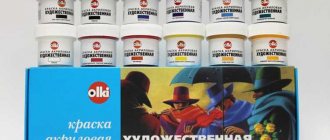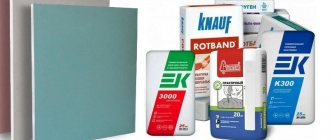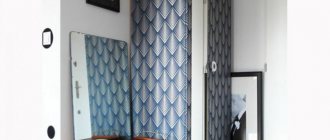The problem probably with all concrete floors is that they generate dust, or rather, sweeping a concrete floor is difficult, since all the sand and all the dust are swept away from it. We were looking for what to do, we searched through a lot of information, tried different floor levelers, also tile adhesive, cement, and so on, but nothing led to the desired result. And then one day I was watching YouTube and accidentally came across liquid glass. Wow, that was something unknown. Essentially, Liquid glass is the same glue (silicate glue). Well, we can say that I found what I was looking for, all that remains is to find where to buy it, since for our town in some stores - Liquid glass is a mystery and something unknown, so I didn’t find it right away. First I took one small 1.4 kg bucket just to see how it would perform
Filled it up. Roughly speaking, 1.4 kg was enough for one and a half square. When it dried, and it took 2-3 days to dry, I liked the result. Closed all the pores. and the floor is not swept.
Well, I took another 10 liters from NSC, but from a different manufacturer
I began to repeat the procedure. I’ll be honest, I didn’t like this Liqui. I didn’t like it because the viscosity is like water, but the manufacturer Ultra has a viscosity like PVA glue. And so we repeat the whole process. spilling it on the floor and rubbing it with a brush. the next day, or rather after a day and a half of drying, it turned into this
On the building materials market today you can find many interesting means for extending the life of buildings, decorating, and creating safe homes. And there are materials that perform all these tasks at once.
These include liquid glass paints, which are actively used in the construction industry and beyond. These are the ones we will talk about. What are these paints? Where can they be used and what are their main features?
What are paints on liquid glass?
Liquid glass paints, also known as silicate paints, are aqueous solutions of liquid glass (with sodium or potassium silicates) with colored pigments. There are two types of such paints:
- Actually silicate coatings, also called two-component: they contain, in addition to glass solution, fillers and pigments. These paints contain no organic compounds.
- Dispersion silicate coatings differ from the first group in that, in addition to the main elements, they also contain a synthetic dispersion and a water repellent. The share of organic components here accounts for no more than 5%.
Let’s immediately say that in the production of paints, liquid glass with potassium silicates is most often used, as it provides a more durable and reliable coating.
Note that paints from the first group are usually used to coat mineral substrates. Since they contain, in addition to potassium liquid glass, pigments and fillers that are resistant to alkalis, such coatings are characterized by good vapor permeability.
The second group of paints is easy to use and is used in various fields. Dispersion silicate paints contain special additives that have water-repellent properties. It is this feature that makes them popular in construction work. Coating walls with this paint significantly increases their service life.
Waterproofing a well with liquid glass
The well must be protected from the inside. The main thing is that its rings are well secured. To improve fixation, you can cover the seam areas with ropes made of flax or jute, coated with liquid glass. They proceed to applying LC, the first layer consists only of glass, the second of cement mixed with sand and glass.
The well must be protected from the inside.
What is liquid glass paint used for?
Paints that are made on the basis of liquid glass can be used to paint brick walls. They are also used for decorating rooms after plastering. Such paints are good to use on surfaces that were once painted with lime, cement or silicate paint. Let us immediately note that it is not recommended to paint surfaces that previously had acrylic or alkyd paint applied with silicate coatings.
Paints based on liquid glass are perfect for both interior and exterior decoration. Today, a separate subtype is presented on the market - facade silicate paints. These decorative coatings are intended for finishing building facades. Due to their characteristics of strength and vapor permeability, these paints will help preserve and protect the facade from external influences for many years.
It should also be noted that coatings based on liquid glass are often used in the automotive industry. For example, since 2008, Japanese manufacturers began producing aerosol paints based on liquid glass for cars.
Which liquid glass for the body to choose
Before processing, it is important to make sure what kind of liquid glass will be used. The fact is that both the application technology and the quality of the composition itself are considered the key to a successful result and lasting effect. Moreover, recently there have been a large number of cheap analogues and low-grade fakes on the market, which also increases the requirements for the quality of the composition.
In general, we can distinguish the leading manufacturers of liquid glass:
- Japanese composition Wilson Silane
- American Mothers
- German Sonax.
At the same time, the first option is most widely used and is considered optimal in terms of quality and price. Other formulations are also of high quality, but the price is higher. Please note that the popular Wilson Silane Guard compound is often counterfeited! For this reason, you need to buy this liquid glass only from trusted suppliers.
Advantages and disadvantages of paints based on liquid glass
We have already mentioned above the characteristics of such paints. In this section we will focus on their main advantages and disadvantages.
Among the main advantages of these paints:
- high vapor permeability;
- fire resistance;
- durability;
- low pollution;
- water-repellent properties (especially for dispersion silicate paints);
- complete environmental safety.
But there are several disadvantages to such coatings:
- small range of colors, which is due to the high alkalinity of the paints themselves;
- the diffusion of carbon dioxide is high, which is why it is not recommended to paint concrete surfaces with it;
Fire resistance of silicate paints
One of the main features of liquid glass-based paints is their fire resistance. Such decorative coatings belong to the class of non-flammable paints.
Their peculiarity is that when dry, these paints form a film that has fire-retardant functions. Paints made from potassium liquid glass are considered to be of the highest quality and resistant to fire.
Typically, non-flammable paints, in addition to glass, also contain special fillers that are highly fire-resistant. It can be ground fluffed or not vermiculite, talc, perlite, kaolin wool fibers, asbestos (fluffed).
Such paints are often supplied in double packaging: a separate mixture of fillers, pigments, additives, etc., and the actual packaging with liquid glass. The paint must be mixed before use. After this, it can only be used for 12 hours.
The characteristics of strength, fire resistance and vapor permeability possessed by paints based on liquid glass have made them indispensable for fire-resistant painting of walls of any premises, creating curtains with fire-retardant properties for cinemas and theaters. These paints will increase the fire safety of any wooden building. In short, when using these paints you will get not only a stylish, but also a safe building.
With the advent of a protective coating based on liquid glass on the construction market, consumers immediately appreciated its unique capabilities. Currently, this composition has a fairly wide scope of use. How is processing done using liquid glass and what is it?
What is liquid glass
This is a special polish composition that penetrates into microcracks and chips on the surface of the body. Due to this, the structure of the enamel coating is completely restored.
The composition of liquid glass (LC) is a complex of chemical polymers based on silica. The polish consists of colorless crystals of high strength, hardness and refractoriness suspended in an alkaline composition. These chemical characteristics provide high strength and insulating properties of LC. The elements in the polish are neutral to the components of the car enamel and do not destroy its structure.
When a vehicle is treated with polishing material, the chemically active elements form a glossy protective film that adheres to the vehicle's paintwork at the molecular level. It prevents particles of dirt, salt, water, and reagents from penetrating and destroying the outer enamel of the car.
What is the material
Silicate glue or, as it is otherwise called, liquid glass is an aqueous solution of silicate salts. Depending on the main component there are:
- sodium liquid glass, characterized by a high degree of adhesiveness, fire resistance, antiseptic and waterproofing properties;
- potassium, which is immune to atmospheric influences and acid attack.
Soda glass is used to accelerate the hardening process of cement mixtures due to the chemical reaction that occurs.
Liquid glass has become widespread as a construction and finishing material due to its properties:
- Hydrophobic (water-repellent). Thanks to this property, liquid glass is used to treat surfaces exposed to prolonged contact with liquid, including wood products. As a result of impregnation, they will not be subject to swelling and deformation.
- Antiseptic. This property allows the use of silicate glue for protective impregnation of walls against such negative manifestations as mold and mildew.
- Fireproof. Impregnating floors and walls with liquid glass increases the fire safety of the room.
- Antistatic. The material eliminates electrification and does not provoke the occurrence of static electricity.
- Acid-resistant. Impregnation with a silicate solution helps protect the surface from exposure to chemicals.
- Eco-friendly. This material does not emit substances harmful to the human body.
Introduction about liquid glass
Silicate glue or, as it is called, liquid glass is prepared in a factory. The main component is a mixture of soda (potash) with silicon dioxide. The result is a white or transparent crystalline substance. There are several types of liquid glass: potassium, sodium, potassium-sodium, sodium-potassium.
The sodium variety is widely used in construction work. Typically, silicate solutions diluted with water are used. Silicate glue applied to the surface interacts with carbon dioxide contained in the air and thereby hardens. Wooden surfaces treated with liquid glass are protected from fungi and mold and, importantly, are fire resistant.
The main tools for applying to wood or cement-concrete surfaces are paint brushes or a spray gun. When using a spray as an application tool, an aqueous silicate solution must be used in a 1:5 combination.
A silicate layer is applied to the outside of the wooden surface, gradually increasing it. It is recommended to dip a small wooden surface into a solution of liquid glass. Before you start laying tiles or plastering the walls, you need to apply liquid glass to them to prevent the appearance of mold and mildew, as well as to protect them from mechanical damage.
Scope of silicate use:
- Bonding porcelain, earthenware, glass surfaces;
Primer of surfaces: concrete, stone, plastered;
Laying linoleum, PVC tiles;
Production of putties for water supply and cast iron pipes;
- Processing tree sections after pruning.
Silicate glue is widely used for the preparation of acid-resistant cement and concrete, for the production of fire-resistant paints and all kinds of wood impregnations, and for gluing cellulose materials. By combining alcohol, fine sand, and liquid glass, “ceramic” slabs are produced, which, after firing at 1000 degrees, serve as molds for the production of metal products. Silicate is included in various building materials: primers, putties.
The main characteristic of liquid glass is its waterproofing properties. To do this, the insulator is combined with cement or concrete mortar in a ratio of 1:10. To increase the water resistance of floors, it is recommended to fill them with an additional layer of glass, 3 mm thick.
When carrying out work on waterproofing wells, a mixture of silicate with cement and fine sand is used. The well is pre-treated with an insulator, then a solution is applied. It is important to note that when applying a silicate coating, it is not necessary to wait for it to completely harden, since the glassy surface does not contribute to good adhesion to the primer or putty.
Waterproof plaster, which you can prepare yourself, will help protect walls from moisture: a combination of liquid glass with cement and sand in a ratio of 1:2:5.
Liquid glass is used for laying stoves and fireplaces; for this, a solution is prepared in the ratio: 1 part cement, 3 parts sand and silicate in an amount equal to 1/5 cement-sand mortar, then pour in water.
The combination of liquid glass (1 part), slaked lime (1 part) and clay (1 part) makes it possible to glue natural stone.
Heat-resistant putty made from liquid glass allows you to glue oven doors. Adding liquid glass to paints allows you to make the product resistant to all types of atmospheric influences.
Application for waterproofing
Due to its chemical composition, liquid glass does an excellent job of filling porous materials:
When the surface is treated with a silicate composition, its hydrophobicity and strength increase. Therefore, liquid glass has become particularly widespread in the processing of foundations, walls and floors of basements, wells and swimming pools. To produce a primer with hydrophobic properties, it is necessary to combine water, cement and ironclad in equal proportions.
The surface to be treated must first be prepared: leveled and cleaned of dirt. When processing wood, it is desirable to preserve its natural unevenness (this will ensure better adhesion of materials). If you had to wet the surface during cleaning, then it must be allowed to dry before processing. The thickness of the waterproofing mortar layer must be at least 3 mm.
Silicate solution is also used when covering floors in a bathhouse or bathroom. To create a hydrophilic coating of a large area, for example, to cover a floor or walls, you can use a spray gun, roller or brush.
Application to increase the fire resistance of materials
The fire resistance of liquid glass allows it to be used for:
- masonry of fireplaces, chimneys and stoves;
- production of heat-resistant concrete and cement, as well as fire-resistant paints and varnishes;
- impregnation of wood to give it fire-retardant properties;
- covering elements of metal structures.
To prepare a fireproof silicate mortar, 3 parts sand, 1 part cement and 1 part liquid glass are required. Such a mixture quickly hardens as a result of the chemical reaction that occurs, so you can first make the necessary structure from ordinary mortar, and then apply an external coating of the concrete with a fire-resistant layer.
To give the surface fire-resistant properties, you can coat wood or concrete only with liquid glass from a spray gun, using it as a primer. Walls can also be impregnated either with a separate solution of silicates or in the form of a cement screed for the floor.
Liquid glass: application in construction
Liquid glass is a unique material that has many properties and is used in various fields. Liquid glass is the most widely used in construction. Let's figure out what can be done with such a material as liquid glass.
The use of liquid glass for waterproofing is very common. It can be used to impregnate both walls and ceilings. In addition, we know that the foundations of buildings are often exposed to atmospheric influences: wastewater, temperature differences, and high humidity can greatly damage the foundation and base of the building. The use of liquid glass in the construction and finishing of foundations and plinths will significantly increase resistance to atmospheric influences.
Let's now imagine that you need to build a swimming pool in your dacha. If you simply dig a hole, line it and plaster it, the water will quickly find its way and the pool will leak: waterproofing is needed. Therefore, in this case, liquid glass is also useful; it was and continues to be used quite often in the construction of swimming pools. The same can be said about wells: waterproofing using liquid glass will also not hurt there.
Our next point is the use of liquid glass as an antiseptic. Quite often we can observe mold and mildew on the walls of residential and non-residential premises. And it doesn’t matter what these walls are made of or how they are decorated, if you don’t take care of antiseptic treatment, the fungus will manifest itself somewhere. Liquid glass is a very good antiseptic.
Liquid glass has good adhesion, that is, it sticks well to the surface, which is why it is used for gluing and bonding various kinds of materials. It can be used to glue cardboard, porcelain, glass, etc.
In order to increase the density and fire resistance of products made from paper, wood or any fabric, they are impregnated with the same liquid glass.
Preparing construction mixtures
Let's approach the issue from a practical point of view and consider what useful things can be done using liquid glass.
Preparation of liquid glass primer. Naturally, no one primes with pure liquid glass; it needs to be diluted.
In order to prepare the primer, in addition to liquid glass, you will also need cement and clean water. For 10 kg of cement you will need approximately the same mass of liquid glass. First, the cement is mixed with water; this can be done using a drill with an attachment (mixer). After which the mixture of cement and water is added to the liquid glass and also stirred.
If the resulting primer hardens too quickly and does not work properly, you need to add a little water and stir.
Waterproofing solution for wells. Before preparing the solution, the sand must be thoroughly sifted. Mix one part sand, one part cement and one part liquid glass.
First, coat the walls of the well with liquid glass, then go over it again with a waterproofing solution.
Production of fireproof mortar. Can be used for laying various types of fireplaces and stoves. There is nothing complicated here: first, prepare a regular cement-sand mortar (1 part cement: 3 parts sand), after which a little liquid glass (15-20% by weight of cement) is added to the solution.
Such a solution should not be diluted in too large portions because it “cools” quickly.
If you want to protect wood from fungus or mold, then you can prepare an antiseptic from liquid glass. Liquid glass is diluted with water 1:1.
It is better not to smear walls made of concrete or plastered with cement-sand mortar with this product. They are covered with a kind of protective film, which is very slippery and further finishing in the form of putty and painting becomes almost impossible.
Preparation of impregnation for the surface of materials. It is necessary to prepare a mixture of water and liquid glass. To do this, you will need to dissolve approximately 400 g in one liter of water. liquid glass. The surface is treated with a brush a couple of times, and there is no need to start re-impregnation until the previous layer has completely dried.
Of course, today there are a lot of materials on the shelves of construction stores: these are primers, waterproofing materials, adhesives, and ready-made fireproof solutions. Therefore, liquid glass in its pure form is an amateur material; sometimes it is better to use a ready-made solution rather than mix something up, observing the proportions. Why reinvent the wheel, right? This liquid glass used to be used in its pure form by everyone and everywhere, but now it is used as a separate ingredient of one or another building mixture.
All this does not mean that liquid glass in its pure form has been completely written off. Some builders continue to actively use it because they have long established their proportions and prepare their own building mixtures, which have been proven over the years.
Pouring the flooring
In bathrooms, showers, bath rooms and indoor swimming pools, which are characterized by constant humidity and wet floors, flooring can be made using liquid glass. To fill the floor you need:
- if wooden floors are laid, then first make a concrete screed;
- pour the silicate solution onto the dry surface in equal portions;
- level the glue layer with a wide spatula;
- carry out final leveling of the layer with a thickness of 3-5 mm using a squeegee;
- After the silicate layer has dried, apply a finishing varnish (polyurethane or epoxy is better).
Full waterproofing
The use of liquid glass for waterproofing porous materials has some peculiarities. However, the method of doing the work is simple and does not require special skills. For waterproofing, wood is treated with liquid glass, concrete, plaster and brick are impregnated.
How to use liquid glass to waterproof a surface:
- Initially, you need to prepare a solution that will prime the surface. Silicate, water and cement are mixed in equal proportions.
- Impregnation of concrete begins only after the base of the surface is completely cleared of old building material.
- Treating wood with silicate is a little more difficult. The surface of wooden decorative items must be cleaned down to the natural base to ensure high-quality adhesion of the materials.
- You should not apply a hydrophobic coating to a wet surface - complete or partial peeling will occur in the future.
- The layer of silicate solution should not exceed 3 mm. In this case, the drying time will be minimal, and the adhesion will be better maintained.
The material is often used as a screed. This is especially true for concrete floor coverings. Wall treatment with liquid glass is carried out according to the principle of puttying or painting. Walls and floors require special care if there is no auxiliary coating, but with liquid glass these problems completely disappear.
Other uses
Liquid glass is also used for many other purposes:
- Silicate glue is widely used as an antiseptic primer for impregnating walls against mold and mildew.
- This material is also useful when laying PVC or linoleum tiles. In this case, the silicate solution will act as glue.
- The high adhesive properties of liquid glass make it possible to use it when sealing or connecting pipes, and caulking joints. In this case, the parts can no longer be disassembled, and if it is necessary to replace one of the elements, the structure will have to be completely dismantled.
- This solution can also be used as an adhesive when repairing furniture made of wood and other materials.
- Gardeners use it to treat trees after pruning. The cut areas become extremely vulnerable to bacteria that spoil the wood. Their putty with liquid glass “seals” the cut and protects the wood from destruction.
Car after protective polishing using liquid glass - This substance can also come to the rescue of housewives: an aqueous solution made in a ratio of 1 to 25 allows you to clean dishes from heavy dirt. To achieve the best effect, it is recommended to boil the dishes in the prepared solution.
- Can be used to remove old paint coatings.
- Silicate solution is even used in agriculture. Experiments have proven that seeds treated with this composition are not susceptible to bacteria and germinate faster.
- Use in wall decoration: when covering walls with glass wallpaper, they are pre-impregnated with liquid glass. This eliminates moisture absorption and increases the wear resistance of glass wallpaper. In some cases, to increase the service life of walls covered with conventional wallpaper and to give them a special shine, a finishing coating is performed with a silicate solution.
- When processing wood products. It is enough to immerse an object made of wood in a container with a silicate solution for some time.
In construction stores, liquid glass is presented in a wide range: both in its pure form and ready-made building materials based on it. Thanks to its low price, this material is available to any consumer, regardless of his income level. The main thing is to choose a composition that is suitable for its characteristics.
Choosing liquid glass for a car
Any composition of liquid glass, regardless of the name or manufacturer, has its pros and cons.
When purchasing polishing material, first of all, you should remember that components for use in specialized auto repair shops are very difficult to apply yourself in a garage or box without additional tools. This requires compliance with special conditions for the room in which all body processing work and special equipment will be carried out. Therefore, purchase formulations for applying components in a non-professional environment. This information is indicated on the packaging.
Currently, there are 6 main types of polishing compounds on the car market:
- HKC ceramic coating 2.2 – Estonia.
- Willson Body Glass Guard - Japan.
- Soft99 Glass Coating H-7 – Japan.
- Gyeon Q2 Prime - South Korea.
- Quartz UK - South Korea.
- Ceramic PRO 9H – Taiwan.
These materials have different prices, but meet the necessary requirements. All samples are intended for self-coating. Does not require the use of additional equipment. They can be used in a covered garage or box. They have high protective and visual properties.
